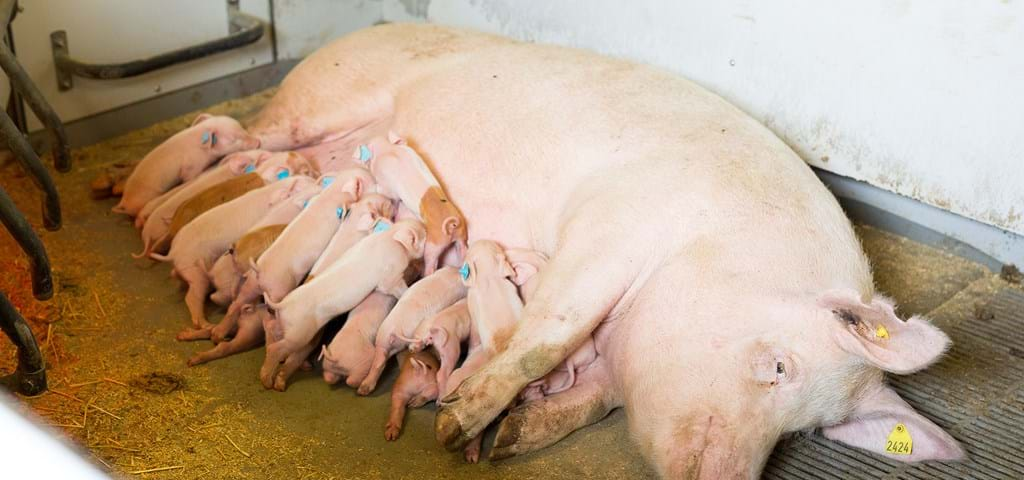
Farrowing pens for loose sows
The farrowing unit can be designed with pens for sows housed loose throughout or most of the nursing period.
These farrowing pens allow a far greater freedom of movement than traditional systems to increase sow welfare. At the same time, productivity is in focus, which puts requirements on layout and dimensioning of the pen.
JLF10
The design of JLF10 provides the sow with complete freedom of movement and opportunity to perform more natural behaviors. The dimensions of JLF10 is based on modern sow production for loose, lactating sows with large litters. There is no equipment in front of the udder, thus providing improved access to the udder, fewer teat fights and calmer nursings with high milk uptake for all piglets in the litter.
The design of the pen ensures that sows are facing the back wall during farrowing. This facilitates easy farrowing assistance and the piglets are born onto the solid floor where floor heat can be incorporated. Floor heat minimizes cooling of newborn piglets and thus improves piglet vitality.
JLF10 SWAP
The design of JLF10 SWAP is based on the principles and benefits of JLF10. However, in the JLF10 SWAP there is an optional additional protection of the piglets during the critical time around farrowing. The front of the creep area is designed to be folded out and used as farrowing wing for a few days around farrowing, during which time the risk of crushing piglets is the greatest. After this critical period, the protection rail is removed - giving the sow full freedom of movement In the majority of the lactation period. The sows' preference for laying with support on solid flooring is met by establishing an extra trough.
The placement of the trough by the aisle ensures a good overview of the sows' feed intake and well-being around farrowing.
JLF15
JLF15 is allowing extra protection for piglets during the critical period around farrowing. The pen dimensions allow good utilization of the area and freedom of movement for the sow. The sow is confined for the first days by use of the protection rails, thereby minimizing the piglet mortality. When confinement is no longer necessary, the sow regains freedom of movement. This provides optimal conditions for the piglets with good access to the udder during lactation.
The floor profile is mostly slatted - either with plastic or cast iron slats, ensuring good hygiene. The creep area is designed with solid floor or a rubber mat to ensure heat for the piglets, and placement of the creep at the aisle is at the same time improving the daily work routines.
FTF/ FT30
In the farrow-to-finish and farrow-to-30 kg pens, the sow is loose housed before, during and after farrowing. The sow is taken out of the pen at weaning whilst the piglets remain in the pen until they reach a weight of 30 kg (FT30) or finishing weight (FTF). When the piglets reach a certain size and they no longer need the covered area, the creep area can be removed by folding in the front of the creep.
Pen Material in the farrowing pens
SKIOLD JYDEN's farrowing pens for loose sows are made of fiber or alternative fiberglass- these are strongest penning materials available. The pen design is the same regardless of whether the material is fiber or fiberglass.The smooth surface of the material reduces the accumulation of bacteria - enabling easy and efficient cleaning. A cleaner housing environment means better hygiene and a lower frequency of diseases, enabling a optimum conditions for animal growth and development.
Both fiber and fiberglass has a minimal thickness of only 10 mm, allowing the pen to be space saving, with the option of more m2 per pen. This is an important factor for new units in particular as it reduces the need for construction and investment. It is possible to adjust the fiber / fiberglass material according to the actual slope of the floor. The penning will fit tightly to the floor, and savings can be achieved as floor clearance can be avoided.


 Tiếng Anh
Tiếng Anh
 Người Đan Mạch
Người Đan Mạch
 Người Pháp
Người Pháp
 Tiếng Thụy Điển
Tiếng Thụy Điển
 Tiếng Việt
Tiếng Việt
 Người Tây Ban Nha
Người Tây Ban Nha
 Tiếng Đức
Tiếng Đức
 Tiếng Anh
Tiếng Anh




